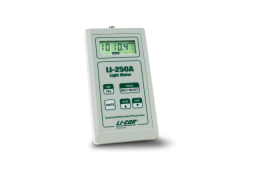Operation summary
The LI-250A Light Meter displays measurements from LI-COR radiation sensors, including the LI-190R, LI-191R, LI-192SA, LI-193SA, LI-200R, and LI-210R. It is compatible with all LI-COR light sensors that have a BNC connector. The LI-250A provides high-resolution reading and conversion of microamp signals from the attached light sensor into suitable light measurement units. The LI-250A does not have a specific calibration; calibrations are associated with the attached light sensor.
Configuration mode vs. measurement mode
The LI-250A has two modes of operation: Configuration Mode, where you enter calibration multipliers for light sensors, and Measurement Mode, where the LI-250A makes measurements. Press the Cal key to switch between modes.
Most of the keys on the 5-button keypad have two functions. The active function depends on whether the LI-250A is in measurement mode or configuration mode. In measurement mode, the keys perform the upper function on each button (in green); in configuration mode, the keys perform the lower function (in white).
Making measurements
- Attach the desired sensor.
- Power on the meter.
- Press and hold the ON key for 2 seconds, and then release. You will be in measurement mode.
- Press CAL to enter configuration mode.
- Press UNITS until the label on the display matches the sensor type.
-
- For Quantum Sensors, select µmol (actual units are µmol s-1 m-2)
- For a Pyranometer, select W m-2 (actual units are Watts m-2)
- For a Photometric Sensor, select Lux or Klux (actual units are Lux or Kilolux)
- Readings will be incorrect if the selected units do not match the sensor that is connected to the meter.
- Press the up or down (▲,▼) key to change the displayed multiplier until it matches the multiplier for your sensor.
- Press and hold the arrow key to scroll rapidly. The multiplier is on the calibration sheet under For use with LI-COR handheld meters and loggers.
- Press CAL again to store the displayed multiplier.
- The LI-250A is ready for measurements.
If you want to store a second calibration multiplier (either for a second sensor or the In Water and In Air multipliers for the LI-192 and LI-193 Underwater Quantum Sensors) press CAL, then press MULT SELECT to switch to the second multiplier. Press the arrow key to change the value of the multiplier, and then press CAL to save it. The multiplier in effect is the one displayed when you press CAL to exit configuration mode.
Note: Pressing MULT SELECT before pressing CAL discards any changes you have made to the multiplier currently shown on the display.
Pressing CAL when in measurement mode will display the multiplier in current use. The multiplier displayed when CAL is pressed again will be stored as the active multiplier, whether you have changed it or not.
While in measurement mode, press HOLD to retain the current reading on the display. Press HOLD again to restore live readings. Press AVG to begin a 15 second average, which will be displayed until you press the HOLD key to resume measurements or the AVG key to start a new average. Press and release the OFF button to power off the LI-250A. It will automatically shut off after 25 minutes of inactivity in measurement mode.
Caution: The LI-250A is weather resistant. However, protect the meter from immersion or prolonged contact with water, especially in marine environments. Water damage is not covered under the warranty.
Power requirements
Power is supplied by one 9-volt battery. Battery life is in excess of 150 hours. A LO BAT message is displayed when there is less than 20 hours of battery life remaining. The battery should be replaced immediately after the LO BAT message is displayed to ensure reliable operation.
The battery compartment is accessed through a screw-retained panel on the back of the instrument case. Remove the battery by lifting on the end of the battery with the terminals. Insert the new battery by pushing straight down on the battery; do not try to insert at an angle. Instruments are fitted with a snap-on connector; simply align the male and female contacts and snap onto the battery.
Although typical battery life is more than 150 hours of continuous operation, it is dependent upon the storage temperature. Do not store the LI-250A at high temperatures.
In some instances, the internal storage is not retained when the batteries are removed or when the batteries become discharged. If the LI-250A is reading 0.0 after replacing the batteries, check the multipliers stored in the instrument and verify that they are correct for each sensor. Re-enter them if necessary.
